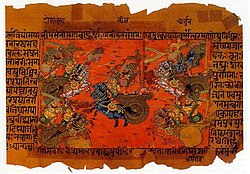Vichitravirya
| Vichitravirya | |
|---|---|
| Information | |
| Family |
|
| Spouse | |
| Children | Posthumously adoptive sons |
| Relatives | Kuruvamsha-Chandravamsha |
Vichitravirya (Sanskrit: विचित्रवीर्य, romanized: Vicitravīrya, lit. 'marvellous heroism')[1] is a figure in the Mahabharata, where he is featured as a Kuru king.
According to the Hindu epic, he is the youngest son of Queen Satyavati and King Shantanu, and the de jure grandfather of the Pandavas and the Kauravas. He is also the half-brother of Krishna Dvaipayana Vyasa and Bhishma.
Literature
[edit]Mahabharata
[edit]Vichitravirya has an elder brother named Chitrāngada, whom his half-brother Bhishma placed on the throne of the kingdom of the Kurus after Shantanu's death; he is a mighty warrior, but the king of the Gandharvas defeats and kills him at the end of a long battle. Thereafter, Bhishma consecrates Vichitravirya, who is still a child, as the new king.[2]
When he had reached manhood, Bhishma marries him to Ambika and Ambalika, the beautiful daughters of the king of Kashi. Vichitravirya loves his wives very much, and is adored by them. But even after seven years of sexual indulgence, he remains childless and falls ill of tuberculosis, and could not be healed despite the efforts of his friends and physicians.[3][4] Like his brother Chitrangada, he dies childless. Subsequently, through a niyoga (levirate) practice f-brother sage Vyasa, his wives and a maid give birth to three children, namely Dhritarashtra, Pandu, and Vidura.[5]
Different texts share different stories surrounding the death of Vichitravirya. According to the Bhagavata Purana, he dies of a heart attack because of his attachment to his wives, Ambika and Ambalika.[6] Vichitravirya was succeeded by Pandu and later Dhritrashtra.
Historicity
[edit]A historical Kuru King named Dhritarashtra, son of Vichitravirya, is mentioned in the Kathaka Samhita of the Yajurveda (c. 1200–900 BCE) as a descendant of the Rigvedic-era King Sudas of the Bharatas.[7][8]
See also
[edit]References
[edit]- ^ Monier-Williams, Sir Monier; Leumann, Ernst; Cappeller, Carl (1899). A Sanskrit-English Dictionary: Etymologically and Philologically Arranged with Special Reference to Cognate Indo-European Languages. Motilal Banarsidass Publishing House. ISBN 978-81-208-3105-6.
{{cite book}}: ISBN / Date incompatibility (help) - ^ van Buitenen (1973), p. 227
- ^ Bhanu, Sharada (1997). Myths and Legends from India - Great Women. Chennai: Macmillan India Limited. pp. 35–6. ISBN 0-333-93076-2.
- ^ Jha, Akhileshwar (1979). Sexual Designs in Indian Culture. Vikas. ISBN 978-0-7069-0744-5.
- ^ van Buitenen (1973), pp. 230; 235-36
- ^ www.wisdomlib.org (29 June 2012). "Vichitravirya, Vichitravīrya, Vichitravirya: 14 definitions". www.wisdomlib.org. Retrieved 9 April 2022.
- ^ Witzel, Michael (1995). "Early Sanskritization: Origin and Development of the Kuru state" (PDF). EJVS. 1 (4): 17, footnote 115. Archived from the original (PDF) on 11 June 2007.
- ^ Michael Witzel (1990), "On Indian Historical Writing", p.9 of PDF
Bibliography
[edit]- Vicitravirya in: M.M.S. Shastri Chitrao, Bharatavarshiya Prachin Charitrakosh (Dictionary of Ancient Indian Biography, in Hindi), Pune 1964, p. 841
- J.A.B. van Buitenen, Mahabharat, vol. 1, Chicago 1973


 French
French Deutsch
Deutsch
